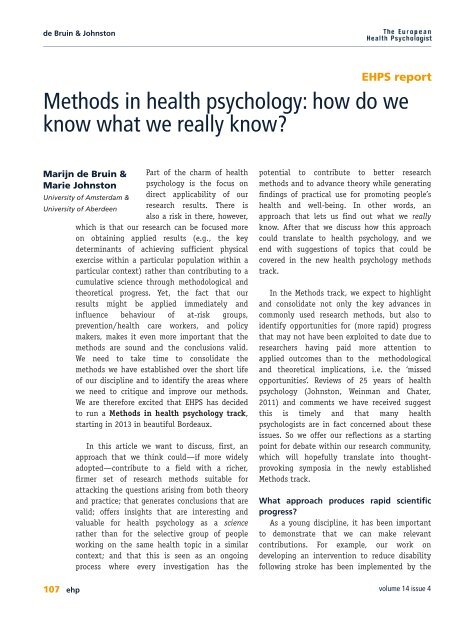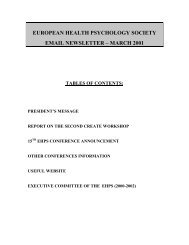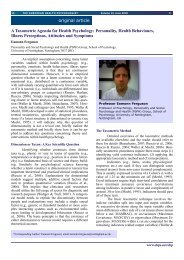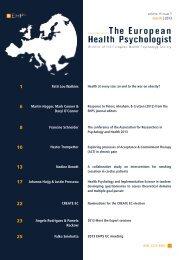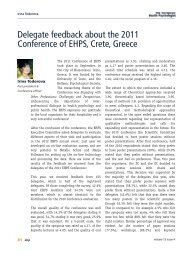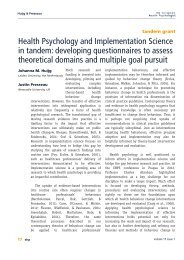Methods in health psychology: how do we know what we really know?
Methods in health psychology: how do we know what we really know?
Methods in health psychology: how do we know what we really know?
You also want an ePaper? Increase the reach of your titles
YUMPU automatically turns print PDFs into web optimized ePapers that Google loves.
de Bru<strong>in</strong> & Johnston<br />
EHPS report<br />
<strong>Methods</strong> <strong>in</strong> <strong>health</strong> <strong>psychology</strong>: <strong>how</strong> <strong>do</strong> <strong>we</strong><br />
<strong>know</strong> <strong>what</strong> <strong>we</strong> <strong>really</strong> <strong>know</strong>?<br />
Marijn de Bru<strong>in</strong> &<br />
Marie Johnston<br />
Part of the charm of <strong>health</strong><br />
<strong>psychology</strong> is the focus on<br />
University of Amsterdam & direct applicability of our<br />
University of Aberdeen<br />
research results. There is<br />
also a risk <strong>in</strong> there, <strong>how</strong>ever,<br />
which is that our research can be focused more<br />
on obta<strong>in</strong><strong>in</strong>g applied results (e.g., the key<br />
determ<strong>in</strong>ants of achiev<strong>in</strong>g sufficient physical<br />
exercise with<strong>in</strong> a particular population with<strong>in</strong> a<br />
particular context) rather than contribut<strong>in</strong>g to a<br />
cumulative science through metho<strong>do</strong>logical and<br />
theoretical progress. Yet, the fact that our<br />
results might be applied immediately and<br />
<strong>in</strong>fluence behaviour of at-risk groups,<br />
prevention/<strong>health</strong> care workers, and policy<br />
makers, makes it even more important that the<br />
methods are sound and the conclusions valid.<br />
We need to take time to consolidate the<br />
methods <strong>we</strong> have established over the short life<br />
of our discipl<strong>in</strong>e and to identify the areas where<br />
<strong>we</strong> need to critique and improve our methods.<br />
We are therefore excited that EHPS has decided<br />
to run a <strong>Methods</strong> <strong>in</strong> <strong>health</strong> <strong>psychology</strong> track,<br />
start<strong>in</strong>g <strong>in</strong> 2013 <strong>in</strong> beautiful Bordeaux.<br />
In this article <strong>we</strong> want to discuss, first, an<br />
approach that <strong>we</strong> th<strong>in</strong>k could—if more widely<br />
a<strong>do</strong>pted—contribute to a field with a richer,<br />
firmer set of research methods suitable for<br />
attack<strong>in</strong>g the questions aris<strong>in</strong>g from both theory<br />
and practice; that generates conclusions that are<br />
valid; offers <strong>in</strong>sights that are <strong>in</strong>terest<strong>in</strong>g and<br />
valuable for <strong>health</strong> <strong>psychology</strong> as a science<br />
rather than for the selective group of people<br />
work<strong>in</strong>g on the same <strong>health</strong> topic <strong>in</strong> a similar<br />
context; and that this is seen as an ongo<strong>in</strong>g<br />
process where every <strong>in</strong>vestigation has the<br />
potential to contribute to better research<br />
methods and to advance theory while generat<strong>in</strong>g<br />
f<strong>in</strong>d<strong>in</strong>gs of practical use for promot<strong>in</strong>g people’s<br />
<strong>health</strong> and <strong>we</strong>ll-be<strong>in</strong>g. In other words, an<br />
approach that lets us f<strong>in</strong>d out <strong>what</strong> <strong>we</strong> <strong>really</strong><br />
<strong>know</strong>. After that <strong>we</strong> discuss <strong>how</strong> this approach<br />
could translate to <strong>health</strong> <strong>psychology</strong>, and <strong>we</strong><br />
end with suggestions of topics that could be<br />
covered <strong>in</strong> the new <strong>health</strong> <strong>psychology</strong> methods<br />
track.<br />
In the <strong>Methods</strong> track, <strong>we</strong> expect to highlight<br />
and consolidate not only the key advances <strong>in</strong><br />
commonly used research methods, but also to<br />
identify opportunities for (more rapid) progress<br />
that may not have been exploited to date due to<br />
researchers hav<strong>in</strong>g paid more attention to<br />
applied outcomes than to the metho<strong>do</strong>logical<br />
and theoretical implications, i.e. the ‘missed<br />
opportunities’. Reviews of 25 years of <strong>health</strong><br />
<strong>psychology</strong> (Johnston, We<strong>in</strong>man and Chater,<br />
2011) and comments <strong>we</strong> have received suggest<br />
this is timely and that many <strong>health</strong><br />
psychologists are <strong>in</strong> fact concerned about these<br />
issues. So <strong>we</strong> offer our reflections as a start<strong>in</strong>g<br />
po<strong>in</strong>t for debate with<strong>in</strong> our research community,<br />
which will hopefully translate <strong>in</strong>to thoughtprovok<strong>in</strong>g<br />
symposia <strong>in</strong> the newly established<br />
<strong>Methods</strong> track.<br />
What approach produces rapid scientific<br />
progress?<br />
As a young discipl<strong>in</strong>e, it has been important<br />
to demonstrate that <strong>we</strong> can make relevant<br />
contributions. For example, our work on<br />
develop<strong>in</strong>g an <strong>in</strong>tervention to reduce disability<br />
follow<strong>in</strong>g stroke has been implemented by the<br />
1 07 ehp volume 1 4 issue 4
www.ehps.net/ehp<br />
methods <strong>in</strong> <strong>health</strong> <strong>psychology</strong><br />
Scottish Government (Johnston et al 2007),<br />
psychometric approaches are now part of the<br />
expected standards <strong>in</strong> the measurement of<br />
<strong>health</strong> outcomes (Bowl<strong>in</strong>g, 2001), and <strong>we</strong> are<br />
currently develop<strong>in</strong>g national guidel<strong>in</strong>es and an<br />
implementation strategy for the delivery of<br />
‘current best practice’ <strong>in</strong> HIV adherence care<br />
based on the results of meta-analyses (de Bru<strong>in</strong><br />
et al, 2009; 2010). Without achiev<strong>in</strong>g this k<strong>in</strong>d<br />
of base, <strong>health</strong> psychologists would not attract<br />
the fund<strong>in</strong>g to cont<strong>in</strong>ue their work. Ho<strong>we</strong>ver,<br />
the drive to produce results that are directly<br />
applicable can result <strong>in</strong> a confirm<strong>in</strong>g and narrow<br />
m<strong>in</strong>d set, and can lead to repetitive work that<br />
<strong>do</strong>es not present a relevant scientific or<br />
theoretical advance (e.g., the umpteenth<br />
observational cross-sectional study s<strong>how</strong><strong>in</strong>g that<br />
the Theory of Planned Behavior (TPB) constructs<br />
expla<strong>in</strong> a <strong>health</strong> behaviour). So <strong>what</strong> m<strong>in</strong>d set<br />
could help us rise above these applicable<br />
outcomes?<br />
In 1964, Platt published a paper <strong>in</strong> Science <strong>in</strong><br />
which he reflected on fields where scientific<br />
progress was more rapid than <strong>in</strong> others.<br />
Accord<strong>in</strong>g to Platt, the usual explanations like<br />
“the tractability of the subject, or the quality of<br />
men drawn <strong>in</strong>to it, of the size of the research<br />
contracts are important but <strong>in</strong>adequate”. He<br />
suggested that <strong>in</strong> the most prolific fields there<br />
is a culture of apply<strong>in</strong>g ‘Strong <strong>in</strong>ference<br />
methods’, of which the separate elements are no<br />
different from “the old-fashioned method of<br />
<strong>in</strong>ductive <strong>in</strong>ference that goes back to Francis<br />
Bacon” (Platt, 1964). What Platt refers to as<br />
Strong Inference is the systematic, formal and<br />
explicit application of the follow<strong>in</strong>g steps<br />
follow<strong>in</strong>g the <strong>in</strong>itial proposition of an<br />
hypothesis, theory or explanation: (1) Formulate<br />
alternative explanations that could expla<strong>in</strong><br />
observed results; (2) Devise a crucial test (or<br />
several) that will exclude one or more of these<br />
explanations; (3) Carry out the research; and<br />
repeat this cycle by mak<strong>in</strong>g sub hypotheses and<br />
december | 201 2<br />
sequential hypotheses to ref<strong>in</strong>e the options that<br />
rema<strong>in</strong>. In this way an <strong>in</strong>itial <strong>in</strong>vention moves<br />
along the branches of a logical tree, with several<br />
options (i.e., hypotheses) at each fork that are<br />
then refuted, leav<strong>in</strong>g one option open which is<br />
then pursued lead<strong>in</strong>g to the next fork, and so<br />
forth, until a particular conclusion has been<br />
reached. Platt observed that <strong>in</strong> the most<br />
productive fields Strong Inference was<br />
<strong>in</strong>tegrated <strong>in</strong> all th<strong>in</strong>k<strong>in</strong>g, publications,<br />
conference presentations, and so forth. So after<br />
one group published their results and<br />
conclusions, <strong>in</strong>clud<strong>in</strong>g possible alternative<br />
explanations and tests, other groups also<br />
pursued these ideas, confirmed or refuted the<br />
hypotheses, presented the alternative<br />
explanations and experiments for their f<strong>in</strong>d<strong>in</strong>gs,<br />
and so forth; progress<strong>in</strong>g efficiently up the same<br />
logic tree.<br />
An <strong>in</strong>terest<strong>in</strong>g side-effect of this approach of<br />
fram<strong>in</strong>g multiple alternative hypotheses for<br />
one’s research f<strong>in</strong>d<strong>in</strong>gs is that people <strong>do</strong> not<br />
become too attached to a s<strong>in</strong>gle hypothesis; <strong>in</strong><br />
fact, researchers can take pride <strong>in</strong> formulat<strong>in</strong>g<br />
alternative hypotheses and clever experiments<br />
that can then be pursued and confirmed or<br />
refuted by others, thereby contribut<strong>in</strong>g to<br />
scientific progress beyond the results of their<br />
own experiments. There are more <strong>in</strong>terest<strong>in</strong>g<br />
ideas <strong>in</strong> this paper, but <strong>we</strong> would like to<br />
highlight this Strong Inference approach s<strong>in</strong>ce<br />
<strong>we</strong> could probably use a bit of this ourselves.<br />
What approach might produce more rapid<br />
progress <strong>in</strong> <strong>health</strong> <strong>psychology</strong>?<br />
So <strong>how</strong> <strong>do</strong>es this rationale translate to <strong>health</strong><br />
<strong>psychology</strong> (Platt reflected on fields like<br />
molecular biology)? We th<strong>in</strong>k, first, that many<br />
of our applied studies permit us to ask more<br />
questions and pose more hypotheses that go<br />
beyond the applied questions, and thereby<br />
contribute to resolv<strong>in</strong>g ongo<strong>in</strong>g theoretical or<br />
metho<strong>do</strong>logical debates. Second, after study<strong>in</strong>g<br />
ehp 1 08
de Bru<strong>in</strong> & Johnston<br />
these <strong>in</strong>itial hypotheses (regardless of whether<br />
these are confirmed or not), <strong>we</strong> could generate<br />
alternative explanations for the results obta<strong>in</strong>ed<br />
and propose methods required to test these<br />
alternative hypotheses. These steps could be<br />
a<strong>do</strong>pted <strong>in</strong> observational and <strong>in</strong>tervention/<br />
experimental studies with diverse research<br />
designs and methods. By focus<strong>in</strong>g our applied<br />
studies more on hypotheses of wider scientific<br />
<strong>in</strong>terest, by generat<strong>in</strong>g alternative hypotheses,<br />
and through critiqu<strong>in</strong>g the methods <strong>we</strong> use, <strong>we</strong><br />
may be able to reach conclusions that are<br />
relevant not only for the application, but which<br />
<strong>in</strong>form theoretical and metho<strong>do</strong>logical<br />
development <strong>in</strong> the field as a whole.<br />
To give an example for observational studies,<br />
let’s return to the example of the TPB (the<br />
umpteenth…). We can see that the results of<br />
such a study may be relevant for the applied<br />
context, but they can additionally test whether,<br />
for example, attitudes are more predictive of<br />
<strong>in</strong>tention than subjective norms, which k<strong>in</strong>d of<br />
attitudes and which k<strong>in</strong>d of subjective norm is<br />
most relevant, or <strong>how</strong> subjective norms can best<br />
be measured; they may also allow simultaneous<br />
test<strong>in</strong>g of different hypotheses about the<br />
<strong>in</strong>tention-behaviour gap brought forward<br />
previously by others (e.g. explanations based on<br />
<strong>in</strong>tention stability, plann<strong>in</strong>g ability, or selfregulatory<br />
skills; e.g. de Bru<strong>in</strong> et al., 2012;<br />
DiBonaventura & Chapmann, 2005; Sniehotta,<br />
Nagy, Scholz & Schwarzer, 2006), or study<strong>in</strong>g<br />
the impact of past behaviour <strong>in</strong> the model (<strong>do</strong>es<br />
it capture habit or <strong>do</strong>es it ma<strong>in</strong>ly control for<br />
confound<strong>in</strong>g?); or exam<strong>in</strong>e <strong>what</strong> is left of the<br />
theory when it is tested us<strong>in</strong>g a with<strong>in</strong>- and<br />
bet<strong>we</strong>en-subject repeated-measures model that<br />
captures change over time; or the difference <strong>in</strong><br />
results when a subjective versus objective<br />
behavioural measure is be<strong>in</strong>g used as the<br />
dependent variable.<br />
To give an illustration for <strong>in</strong>tervention<br />
studies, consider the example of an <strong>in</strong>tervention<br />
directed at <strong>in</strong>creas<strong>in</strong>g the uptake of an effective<br />
treatment. Whereas for that study the key<br />
outcome is whether it <strong>do</strong>es <strong>in</strong>deed result <strong>in</strong> an<br />
improved uptake, one might also test theoretical<br />
or metho<strong>do</strong>logical hypotheses of wider <strong>in</strong>terest,<br />
such as whether the delivery of particular<br />
behaviour change techniques <strong>in</strong>deed produce<br />
the <strong>in</strong>tended change <strong>in</strong> determ<strong>in</strong>ants and<br />
behaviour, and if so for whom and under <strong>what</strong><br />
conditions; evaluate the role of demand<br />
characteristics (McCambridge, de Bru<strong>in</strong>, &<br />
Witton, 2012) and other potential sources of<br />
bias; compar<strong>in</strong>g different methods for assess<strong>in</strong>g<br />
and controll<strong>in</strong>g for variability <strong>in</strong> care provided<br />
to control groups; or compar<strong>in</strong>g the feasibility<br />
and accuracy of different measures for assess<strong>in</strong>g<br />
the quality of <strong>in</strong>tervention delivery. If <strong>we</strong><br />
identify the ‘hot topics’ <strong>in</strong> our field, and <strong>in</strong> our<br />
applied studies consistently pit hypotheses<br />
directed towards such theoretical and<br />
metho<strong>do</strong>logical questions aga<strong>in</strong>st each other, as<br />
a field <strong>we</strong> could become much more efficient <strong>in</strong><br />
understand<strong>in</strong>g the processes <strong>in</strong>volved and the<br />
conditions under which each of these<br />
hypotheses may hold.<br />
So <strong>how</strong> is this l<strong>in</strong>ked with the start<strong>in</strong>g po<strong>in</strong>t<br />
of this paper, namely a new EHPS conference<br />
track on research methods? We th<strong>in</strong>k that by<br />
putt<strong>in</strong>g more emphasis on methods, <strong>we</strong> will be<br />
able to ask the questions and present the<br />
evidence compatible with a<strong>do</strong>pt<strong>in</strong>g a Strong<br />
Inference approach. Upon hear<strong>in</strong>g an<br />
explanation for a result, <strong>we</strong> will have the<br />
opportunity to ask the question ‘But <strong>what</strong><br />
<strong>in</strong>vestigation could disprove your hypothesis?’<br />
(cf. Platt), and to reflect at a higher level on the<br />
scientific nature of our research (e.g.<br />
formulation of <strong>in</strong>itial and alternative hypotheses<br />
beyond the applied question at hand) and on<br />
<strong>how</strong> our designs, measures and<br />
analytical/statistical models could be<br />
challenged. Our hypothesis (or hope) is that by<br />
1 09 ehp volume 1 4 issue 4
www.ehps.net/ehp<br />
methods <strong>in</strong> <strong>health</strong> <strong>psychology</strong><br />
<strong>in</strong>creas<strong>in</strong>g the emphasis on improv<strong>in</strong>g our<br />
methods, <strong>we</strong> will encourage the research<br />
practices compatible with a Strong Inference<br />
approach, which could lead to an—if not<br />
exponential, than a substantial—<strong>in</strong>crease <strong>in</strong> the<br />
advancement of our theory, the quality of<br />
research methods, and the impact of our<br />
research.<br />
What metho<strong>do</strong>logical issues <strong>do</strong> <strong>we</strong> need to<br />
address?<br />
There are numerous metho<strong>do</strong>logical challenges<br />
<strong>in</strong> the field of <strong>health</strong> <strong>psychology</strong>. We <strong>in</strong>vite you<br />
to propose your ideas and symposia for the<br />
methods track for the 2013 conference and for<br />
subsequent conferences. In order to illustrate<br />
the breadth of topics <strong>we</strong> might consider, the<br />
Table 1. Possible metho<strong>do</strong>logical questions that could be central to a symposium<br />
december | 201 2<br />
ehp 1 1 0
de Bru<strong>in</strong> & Johnston<br />
1 1 1 ehp volume 1 4 issue 4
www.ehps.net/ehp<br />
methods <strong>in</strong> <strong>health</strong> <strong>psychology</strong><br />
table identifies potential metho<strong>do</strong>logical topics<br />
and questions as they may occur throughout the<br />
process of research reported <strong>in</strong> a typical journal<br />
article or research grant application. Topics for<br />
future methods symposia might be derived from<br />
these or other topics—but no <strong>do</strong>ubt you will<br />
have ideas that are more orig<strong>in</strong>al than ours. We<br />
hope that with this paper, a yearly symposium<br />
on <strong>Methods</strong> <strong>in</strong> <strong>health</strong> <strong>psychology</strong> of which an<br />
overview will be presented <strong>in</strong> this Bullet<strong>in</strong>, and<br />
the Metho<strong>do</strong>logy track, <strong>we</strong> will see an <strong>in</strong>creased<br />
rigor and impact of our discipl<strong>in</strong>e.<br />
References<br />
Johnston, M., We<strong>in</strong>man, J., & Chater, A. (2011). 25 years of<br />
Health Psychology <strong>in</strong> the BPS. The Psychologist, 24,<br />
890-892.<br />
Johnston, M., Bonetti, D., Joice, S., Morrison, V., & Francis,<br />
J.J., & MacWalter, R. (2007). Recovery from disability<br />
after stroke as a target for a behavioural <strong>in</strong>tervention:<br />
Results of a ran<strong>do</strong>mised controlled trial. Disability &<br />
Rehabilitation, 29, 1117-27. <strong>do</strong>i: 10.1080/<br />
03323310600950411<br />
Bowl<strong>in</strong>g, A. (2001). Measur<strong>in</strong>g disease: a review of diseasespecific<br />
quality of life measurement scales. Open<br />
University Press, Buck<strong>in</strong>gham.<br />
de Bru<strong>in</strong>, M., Viechtbauer, W., Hospers, H.J., Schaalma,<br />
H.P., & Kok, G. (2009). Standard care impact on effects<br />
of highly active antiretroviral therapy adherence<br />
<strong>in</strong>terventions: A meta-analysis of ran<strong>do</strong>mized<br />
controlled trials. Health Psychology, 28, 668-74. <strong>do</strong>i:<br />
10.1037/a0015989<br />
de Bru<strong>in</strong>, M., Viechtbauer, W., Schaalma, H.P., Kok, G.,<br />
Abraham, C., & Hospers, H.J. (2010). Standard care<br />
impact on effects of highly active antiretroviral therapy<br />
adherence <strong>in</strong>terventions: A meta-analysis of<br />
ran<strong>do</strong>mized controlled trials. Archives of Internal<br />
Medic<strong>in</strong>e, 170, 240-50. <strong>do</strong>i: 10.1001/arch<strong>in</strong>ternmed.<br />
2009.536<br />
Platt, J.R. (1964). Strong Inference: Certa<strong>in</strong> systematic<br />
methods of scientific th<strong>in</strong>k<strong>in</strong>g may produce much more<br />
rapid progress than others. Science, 146, 347-53. <strong>do</strong>i:<br />
december | 201 2<br />
10.1126/science.146.3642.347<br />
de Bru<strong>in</strong>, M., Sheeran, P., Kok, G., Hiemstra, A., Pr<strong>in</strong>s,<br />
J.M., Hospers, H.J., & van Breukelen, G.J.P. (2012).<br />
Self-regulatory processes mediate the <strong>in</strong>tentionbehavior<br />
relation for adherence and exercise behaviors.<br />
Health Psychology, 31, 695-703. <strong>do</strong>i: 10.1037/<br />
a0027425.<br />
DiBonaventura, M.D., & Chapman, G.B. (2005). Moderators<br />
of the <strong>in</strong>tention-behavior relationship <strong>in</strong> <strong>in</strong>fluenza<br />
vacc<strong>in</strong>ations: Intention stability and unforeseen<br />
barriers. Psychology and Health, 20, 761-774.<br />
<strong>do</strong>i:10.1080/14768320500183368<br />
Sniehotta, F.F., Nagy, G., Scholz, U., & Schwarzer, R.<br />
(2006). The role of action control <strong>in</strong> implement<strong>in</strong>g<br />
<strong>in</strong>tentions dur<strong>in</strong>g the first <strong>we</strong>eks of behaviour change.<br />
British Journal of Social Psychology, 45, 87-106.<br />
<strong>do</strong>i:10.1348/014466605X62460.<br />
McCambridge, J., de Bru<strong>in</strong>, M., & Witton, J. (2012). The<br />
effects of demand characteristics on research<br />
participant behaviours <strong>in</strong> non-laboratory sett<strong>in</strong>gs: a<br />
systematic review. PLoS One, 7, e39116.<br />
<strong>do</strong>i:10.1371/journal.pone.0039116.<br />
Marijn de Bru<strong>in</strong><br />
m.debru<strong>in</strong>@uva.nl<br />
Marie Johnston<br />
m.johnston@abdn.ac.uk<br />
ehp 1 1 2


